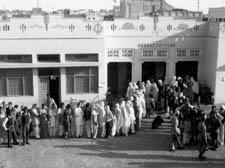
A group of mostly Muslim women queueing to vote in the first general election, old Delhi, February 1952 |
Sixty, and still single
As India prepares to celebrate 60 years of democracy – the question is, what kind of democracy? Review by Dilip Hiro
India After Gandhi: The History of the World’s Largest Democracy, Macmillan, £25. order this book
ON August 15, India will celebrate the 60th anniversary of independence from Britain. To the surprise and satisfaction of many, in that 60 years India has been a functioning democracy.
Viewed in retrospect, violent events that have peppered Independent India’s history – stemming from hostility between people of different religions, languages, and races – can be seen as part of the growing decentralisation of the polity, a steady drift away from the primacy of a single region (the North), a single party (the Congress), and a single family (the Nehru-Gandhis).
Ramchandra Guha, a Bangalore-based academic-turned-writer, has set out to explain how this multi-ethnic, multicultural country of more than one billion souls has survived as a single political-administrative unit wedded to secular democracy.
The reference to Gandhi in the title is to (Mahatma) Mohandas Karamchand Gandhi, who was assassinated by a fanatic Hindu five months after the independence and partition of British India in August 1947.
The author’s narrative validates his observation that the partition of the Indian sub-continent has impacted on independent India’s demography, economics, culture, religion, law, international relations, and party politics.
With whom lies the responsibility for the partition? With the Indian National Congress led by Mahatma Gandhi and Jawaharlal Nehru, the Muslim League headed by Muhammad Ali Jinnah, and the British government, argues Guha, convincingly.
While accepting partition, stemming from Jinnah’s argument that Hindus and Muslims constituted two separate nations, Congress leaders rejected the two-nation theory. They adopted secularism as a pillars of the Republic of India, thus according equal political rights to all religious minorities in an overwhelmingly Hindu country.
The primary credit for making secularism stick rested with Nehru. He deployed his charisma to the hilt to overcome the forces of religious bigotry among Hindus.
He was also a staunch democrat. That was why during the first two decades of independence, dominated by him until his demise in 1964, the Indian polity functioned as a constitutional democracy. The legislation was debated and passed by a parliament composed largely of politicians loyal to parties with coherent programmes.
This changed during the premiership of Nehru’s daughter, Indira, who acquired the family name of Gandhi after marring Feroze Gandhi, a Zoroastrian, who did not live to see his wife reach the pinnacle of power, much less her dictatorship during 1975-76.
Under Indira Gandhi’s tutelage, the Congress Party manipulated the democratic constitution to garner more authority for itself while Indira dispensed with inner-party democracy, and turned herself into Sole Leader.
This drove the opposition to resort to an extra-constitutional campaign and attempt to de-legitimise elected government and its right to govern.
By the time Indira Gandhi was assassinated by two of her Sikh bodyguards in 1984, the Indian polity had changed for the worse. The rot has continued. Now, barring a few notable exceptions, political parties and politicians have abandoned ideology and principles and opted for expediency and material gain.
The events of the past two decades call for a new qualifying adjective, says Guha. India is no longer a constitutional democracy but a populist one.
On the other hand, democracy has taken root in the Indian soil. A glaring example of this is the rise of coalition governments, first in the States and then at the Centre.
It is a manifestation of different groups and regions garnering a larger stake in the political system, with the parties representing them gaining ground at the cost of the Congress Party which claimed to represent national interests.
Increasingly aware of the power of the vote, the more numerous Hindus of middles castes have displaced the minority upper castes from the seats of authority. And traditionally underprivileged groups of outcastes, now called Dalits, non-unionised workers and women have resorted to novel forms of assertion. Non-governmental organisations specialising in environmental issues and civil liberties have sprung up.
The many merits of this book include nuggets from Guha’s copious research. Despite strict censorship during the Emergency, one V Balasubramanyam published an article in the Eastern Economist, with the opening line: “There are at present 580 million sheep in the country.”
And an advertisement in The Times of India announces “the death of D. E. M. O’Cracy, mourned by his wife T. Ruth and son L. I. Bertie”.
|



